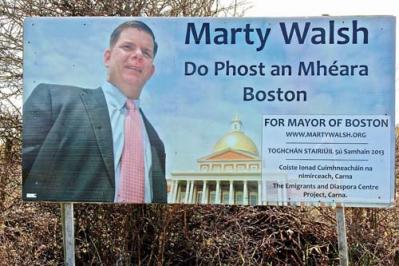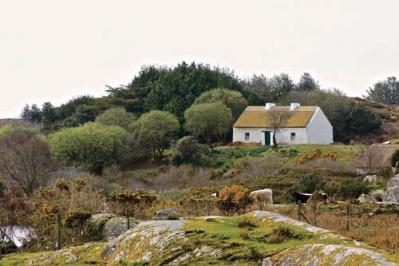August 29, 2014
By Judy Enright
 There was a very large billboard in Carna, Co. Galway, this spring celebrating Boston’s Irish Mayor Marty Walsh. The Connemara area will be thrilled to have him visit this autumn.
There was a very large billboard in Carna, Co. Galway, this spring celebrating Boston’s Irish Mayor Marty Walsh. The Connemara area will be thrilled to have him visit this autumn.
Boston Mayor Martin Walsh has already taken Connemara by storm and he hasn’t even touched down on Irish soil for his first “official” visit. This spring, we came across a huge billboard applauding Walsh’s mayoral run at an intersection in Carna (Connemara, Co. Galway) where his father, John, was born.
Connemara is just one of many areas Walsh plans to visit when he lands in Ireland later this month and it’s an area he knows well from childhood visits to his grandparents’ home in Rosmuc.
Isn’t Walsh a lucky man? You could scarcely find a more varied or picturesque area of this stunning country to visit than Connemara – and he has familial roots there to boot.
Connemara really has it all – bogs, mountains, seashore, a fjord, wonderful hotels, lodges and B&Bs, great fishing, golf and many other sports, delicious food, friendly people, so-called green gold (Connemara marble), colorful towns, tourist attractions, including the first transatlantic radio station, and Connemara ponies – what more could anyone want?
It’s all very exciting for Boston - and for Walsh, his family and Connemara. We wish the mayor a wonderful trip and we know he’ll enjoy every minute.
And, in case you missed the story, there’s another Boston Walsh grabbing headlines in Ireland these days: Philadelphia’s Rose, Maria Walsh, a Boston native, has been crowned as the 2014 Rose of Tralee. Maria moved to the south Mayo village of Shrule in 1994.
Her father, Vincent, is from Carravilla, Roundfort, Co. Mayo, but lived in Boston for a number of years. Her mother was born in Boston but moved to Leitir Mor in Connemara when she was seven and returned to Boston in her early twenties.
PATRICK PEARSE
Students of Irish history will no doubt be well acquainted with the writer and poet Patrick Pearse, one of the patriots who led the 1916 Easter Rising. Although Pearse was executed along with 15 others for his involvement, the Rising was far from his only claim to fame. He was a teacher, writer, poet, and barrister. He devoted much of his life to preserving the Irish language and started an Irish-speaking school for boys in Dublin called St. Enda’s.
 The site around Patrick Pearse’s summer home in Connemara is about to undergo extensive development and will eventually include an interpretive center, entrance building, walking trail and more. Judy Enright photos
The site around Patrick Pearse’s summer home in Connemara is about to undergo extensive development and will eventually include an interpretive center, entrance building, walking trail and more. Judy Enright photos
On his first visit to Connemara in 1903, the warmth of the people, their unique traditions and rich culture, and the beauty of the landscape captivated him. He later bought a site in Inbhear, near Rosmuc, with a view of Lough Eiliarach and distant mountains, and had a two-bedroom thatched cottage built as a summer residence and summer school for students from St. Enda’s. That cottage, now a national monument, attracts thousands of visitors every year when open to the public from April to September.
Pearse’s cottage and its surroundings will soon to be the focal point in a major project by Udaras na Gaeltachta, a regional state agency responsible for the economic, social, and cultural development of Gaeltacht (Irish speaking) regions of the country. Plans include construction at Pearse’s homestead of a Connemara Cultural Center and interpretive institution with two new buildings that will have exhibition space, education rooms, a library/archive, AV room, and café. The new center has been designed to be sensitive to the rural environment and planners hope it will draw many more visitors to this Gaeltacht area of Connemara and encourage economic activity within the community.
UNDISTURBED VIEWS
We recently met with Sonya Nic Lochlainn, Udaras senior executive for policy and planning, to talk about the project and the extensive amount of research that was undertaken before any plans were put forward. Part of that focus involved looking ahead to commemorations planned for the centennial of the 1916 Rising.
One of many reasons the Pearse cottage site was chosen, she said, was because it is among just a few places “where there are the same undisturbed views today that he would have had 100 years ago” when the cottage was built. The simple whitewashed cottage looks out on a spectacular natural panorama of pristine lakes and the rugged Twelve Bens mountains.
“Why did he come here in the first place? Was it the people, the culture, the language, the seascape – or all of those? We’ll turn it on its head and investigate those various themes through the eyes of Patrick Pearse as a visitor. This was the cottage where he drew inspiration for his writing and where he wrote his short stories.” She added that he wrote in English and Irish.
Pearse’s father, James, was English but moved to Dublin as a mason and sculptor. Patrick had “a culturally rich background in the arts,” Nic Lochlainn said, “and he would have traveled extensively.”
On 10 acres around the cottage, she said, Udaras will develop a visitor center with other attractions such as walking trails, a woodland building, and guided tours. Extensive research was done to determine what kind of project might be sustainable and also meet expectations of residents and visitors.
The project will include gradual paths and walks through the ten acres and native flora and fauna will be preserved. “We want to tie in the nature of the landscape with his view of education and leave the site as close as possible to what it was,” she said.
The new center, according to Udaras, “aims to become a hub for celebrating Gaeltacht culture and Irish as a contemporary, living language while highlighting the Connemara region’s outstanding natural beauty. It will also provide expanded interpretation about Patrick Pearse.”
Nic Lochlainn added that the Connemara Center “will have something for everyone.” There will be event space, a small library area for those researching local genealogy, an exhibit section, and a small retail area and café. She anticipates that the Center will become a hub for walkers and cycle tours.
“One of the benefits we see is that it will generate new business and create jobs and social enterprises in the area and cottage industries like crèches and other child care facilities,” she said. “We want to ensure that there is sufficient strength in terms of Irish language and contemporary culture, celebrate the vibrancy of the language, and tell all the stories.”
The Irish government has included the Connemara Cultural Center as one of the flagship capital projects under the 1916 Commemorations’ Program. Half a million euro have been provided this year alone to advance this project, she said. Work is expected to start next spring and the Center is targeted to open in 2016.
SEPTEMBER IN IRELAND
Don’t forget, if you’re fortunate enough to be visiting Ireland in September, that there are still many events to enjoy all over the country even though summer is just a memory.
• Dunmanway, in Co. Cork, celebrates the life of Sam Maguire, who gave his name to the most coveted trophy in Irish sport, on Sept. 12. There’s a festival and welcome home gathering that features open air dancing, a parade, and vintage exhibit. See dunmanway.ie for details.
• On Sept. 19, more than 900 venues across the country will take part in Culture Night, from 5 to 11 p.m., and offer hundreds of free events for every age and interest including music, theatre, tours, talks, and performances. Go to culturenight.ie for more information and to find special events in the area you’re visiting.
• If you’re in the Galway area from Sept. 25 to Sept. 28, don’t forget the 60th International Oyster and Seafood Festival at the Spanish Arch in Galway City. For details, visit galwayoysterfestival.com
• Dunshaughlin’s Harvest Festival in Co. Meath will also run from Sept. 25 to the 28th and feature dancing, music, drama, food, crafts, sports and games for children. See dunfest.com for more.
Enjoy Ireland whenever you go and be sure to visit Ireland.com, Tourism Ireland’s excellent and constantly updated website, for the latest information on things to do, places to stay, and more.

